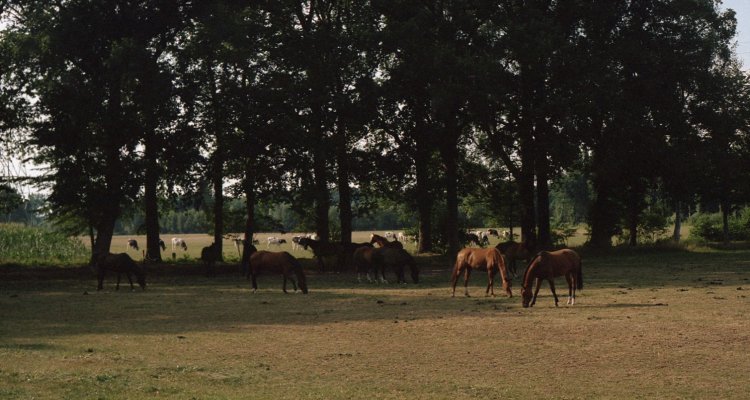
Project
Nature-based transitions: socio-economic and legal solutions for climate-robust, sustainable and productive sandy-soil landscapes
The Netherlands was always a country of water abundance, where intensive agricultural production was facilitated by draining land. Recent periods of prolonged droughts have changed that perspective quite dramatically. It has become evident that landscapes in the Netherlands are under severe stress by intensive agricultural use, groundwater extraction, and climate change.
This is particularly true for the sandy-soil landscapes that drain fast and face limited fresh water supply. Societal actors currently lack the incentives to transform to a climate-robust future, mostly because many landscape functions are valuable to society, but private individuals are not compensated for their provision. Insights on how the design of economic incentives and regulatory systems can unlock a transformation towards climate-robust production systems are urgently needed.
Project description
Since the late nineteenth century, and especially after the famine in the last year of the Second World War, productivity has been the highest priority of agricultural systems in the Netherlands. This development was supported by the European Common Agricultural Policy entering into force in the nineteen fifties, which stimulated large land consolidation projects and heavy modifications of water systems to drain surplus water and enable irrigation (Bressers et al., 2016; Brockhoff et al., 2022).
However, multiple consecutive dry years, most recently between 2018 and 2020, demonstrated that water surplus is no longer the sole water-related challenge on Dutch sandy-soils. Drought is becoming increasingly problematic as a consequence of climate change. Various sources claim that 2018 drought damages amounted to €820 – €1,400 million to agriculture and €500 million to nature (Beleidstafel Droogte, 2019; The Netherlands National Strategic Plan CAP 2023-2027, 2023; van Hussen et al., 2018).
The recent droughts show that especially arable farmers on sandy-soils were affected by the lack of sufficient ground and surface water of sufficient quality. This is largely attributable to the characteristics of sandy-soils, which are generally porous and low in organic matter (Huang & Hartemink, 2020). Farmers of beets and starch products were significantly affected by increased costs of production that were not accounted for in product pricing (van Hussen et al., 2018). In Friesland, a total ban on irrigation was even imposed, leading to drastic consequences for the yields of the affected farmers.
Climate change requires a refocus of current land and water use systems on sandy-soils. A transition is needed to move from systems that are solely adapted to manage excess water towards ones that are adapted to provide sufficient water during scarcity. Although current laws, strategies and policies such as the Dutch Water Law (Waterwet, 2021), Provincial Climate Strategies and the Netherlands National Strategic Plan CAP 2023-2027 (2023) are starting to address drought, the main focus is still on flooding and water pollution. In addition, the mobilization of financial resources is limited and actors in various parts of the value chain are still hesitant to take action (Bressers et al., 2016). As with many transitions, this inertia can be explained by the fact that transitions are complex processes, with many different and interrelated dimensions – technical, socio- economic, legal, geospatial, temporal –, a high degree of uncertainty and diverse groups of stakeholders with sometimes conflicting interests (Antrop, 1998; Nijp et al., 2019).
Nature-based approaches, which can be broadly defined as actions that are inspired by, or utilize nature, are increasingly being put forward by policy makers and scholars as potential pathways to tackle climate mitigation and adaptation challenges at relatively low-cost while delivering multiple additional benefits such as improving biodiversity and socio-economic conditions (European Commission Directorate General for Research and Innovation, 2015; Sarabi et al., 2019, 2020). Acknowledging the diffuse definition, nature-based approaches are understood as an umbrella concept that can concern a multitude of actions which are diverse in terms of the type of action they pertain (i.e., spatial planning, land management), degree of utilization of nature, scale, point of intervention and impact (Keesstra et al., 2018; Polo-Ballinas et al., 2022; Seddon et al., 2020). Following the adage “aligning land use with local soil and water conditions”, Dutch policy frameworks have recently started advocating for nature-based approaches to tackle drought challenges on sandy-soils such as the restoration of stream valleys, the implementation of nature buffer zones and agroforestry (Baptist et al., 2019; Beleidsregel Natuur Overijssel, 2017; Nationale Omgevingsvisie (NOVI), 2022; Seddon et al., 2020; Telwala, 2023).
Although the principles and objectives seem promising, the implementation of nature- based approaches often remains impeded by a number of barriers which can collectively be referred to as a ‘lock-in’ into the prevailing system (Biesbroek et al., 2017; Bressers et al., 2016; Brockhoff et al., 2022; Sarabi et al., 2020; Sieber et al., 2018). Barriers often relate to issues with social acceptability and economic viability, and concern factors such as a lack of financial resources and incentives, political fragmentation, distrust in authorities, a lack of problem perception and performance uncertainties.
In line with the aforementioned challenges, the overarching research question is formulated as follows: “how can land and water use align with natural resources in a changing climate, and yet be economically viable and socially acceptable?” The research addresses drought challenges on sandy-soils in particular, and investigates how nature-based approaches to land and water use systems might contribute to drought-robust landscapes and socio-economic welfare. In line with this focus, investigating the potential role of water policies and regulations in facilitating or impeding the economic viability and social acceptability of nature-based landscapes is considered a key research objective.